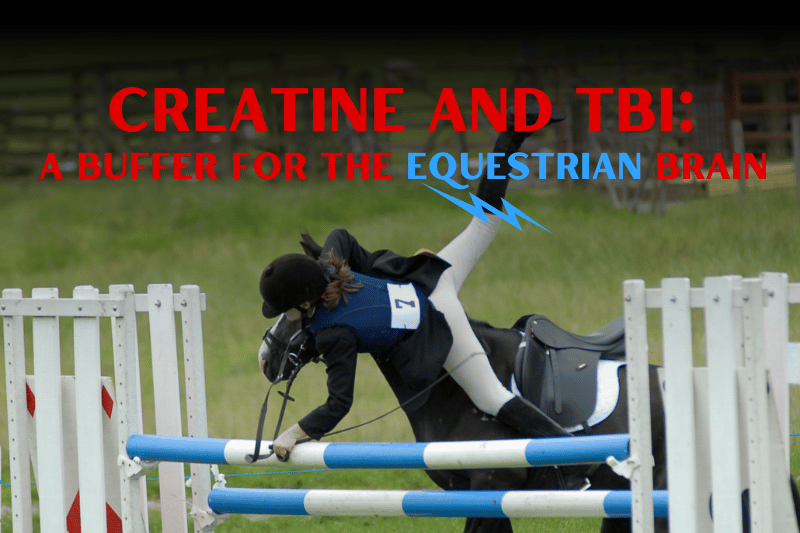Equestrians sports account for the highest percentage of sports-related traumatic brain injuries in the United States. 70% of rider falls reported in this study involved head trauma, primarily concussions, even when helmets were worn.
Though sobering, these statistics are unlikely to stop us horse lovers from saddling up and taking our chances. What if there was an affordable, safe supplement that could mitigate harm in the event of head injury in riders?
As it turns out, there is.
What is Creatine?
Creatine is an amino acid compound whose primary role is to maintain energy balance within your cells as energy demand rises and falls. The majority of your creatine is stored in muscle tissue, but it’s also found in organs, particularly your brain.
Your body produces some creatine naturally, and you can take in more through diet and supplementation. The major dietary sources are red meat and seafood, so vegetarians in particular can benefit from supplementing with creatine monohydrate, which has the happy characteristics of being both inexpensive and well-researched.
Like many athletes, I have supplemented with creatine for years due to its extensively-documented performance benefits. More recently, I’ve become aware of an equally intriguing reason for equestrians to consider creatine supplementation: TBI.
Creatine and Equestrian Head Injury
Every equestrian knows that, even with the religious application of helmets, our sport puts us at increased risk of traumatic brain injury. So, it’s fantastic news that a growing body of research indicates creatine supplementation can help minimize the negative impact of TBI.
A TBI causes a significant energy crisis in your brain. Blood flow – and therefore oxygen availability – is disrupted, and creatine levels in the brain drop. Because creatine supports cellular energy balance by helping restore adenosine triphosphate (aka ATP, which is basically the fuel for cellular function), you want plenty of it on hand.
Fortunately, both pre- and post-injury creatine supplementation appear to promote recovery from TBI.
Both pre-and post-injury creatine supplementation appear to promote recovery from TBI.
If that’s not good news for riders, I don’t know what is.
According to this excellent article by Candow, D.G., Forbes, S.C., Ostojic, S.M. et al.,
“Creatine reduced the duration of post-traumatic amnesia, intubation time, and intensive care unit stay, in addition to improving disability, good recovery, self-care, communication, locomotion, sociability, personality and behavior, and neurophysical and cognitive function. Further, creatine improved post-traumatic headaches, dizziness and fatigue, dysarthria, and lingual problems of understanding.”
If that’s not good news for riders, I don’t know what is.
I have added high-dose creatine supplementation to my list of instructions for family members to follow if I end up in the hospital unable to advocate for my own care. (Yes, I do have a list like that. Do you? Make one now with my free I.C.E. Pack.)
Would first responders, friends, or strangers know how to help if you were injured around the stable or on the trail? My free I.C.E. Pack includes printable placards for barn and trailer, cards for rider and horse, and instructions for friends and family. Get yours now.
If you really want to nerd out on the nuances of creatine supplementation, with extensive links to studies, that Candow et al article is a great place to start. For additional information in layman’s English, check out these videos:
Dr. Andrew Huberman on creatine for headaches and TBI
Peter Attia and Layne Norton on creatine safety, mechanism, and efficacy
Additional Benefits of Creatine for Equestrians
Even if your horse doesn’t turn you into a lawn dart, your money won’t be wasted on creatine supplementation. Multiple studies indicate that boosting your creatine levels also:
- Improves muscle mass, strength, and endurance in people of all ages and fitness levels
- Improves cognitive function during times of metabolic stress, such as sleep deprivation (hello, competition weekend!)
- Improves symptoms related to neurogenerative diseases and mood disorders
If you go down the research rabbit hole, you’ll see that creatine isn’t just for athletes and TBI sufferers. I’ve gotten all my family members on it, including an elderly female looking to maintain muscle while recovering from injury and an older male showing signs of dementia.
So, how do you take the stuff?
How to Supplement with Creatine
Most sources agree that long-term creatine supplementation is generally quite safe. There are possible exceptions in the context of liver or renal disease, bi-polar, diabetes, and pregnancy, so it’s always a good idea to ask your doc first. Also, be aware that some people notice a small amount of (harmless) water retention when taking creatine.
Creatine monohydrate is the form of choice, as it’s the most bioavailable. You can get it in capsules, gummies, or powder. Micronized powders have smaller particles that dissolve easily in liquid.
Happily, creatine is not generally a banned substance in competition (for humans, that is). If you compete in a sport that tests, just look for a brand that is NSF certified to avoid any possibility of cross-contamination.
I use Thorne because they have an excellent reputation for quality, but there are plenty of options on the market, including more economical ones. (In the past, I’ve used this one from Bulk Supplements, which comes at a lower price point.) The powder is cheaper than capsules, and it’s tasteless mixed into a smoothie or a couple ounces of fruit juice.
To top up your creatine levels quickly, you can take a loading dose of 20 grams per day for the first week. However, doing so might make you feel a little bloaty or nauseated. It’s just as effective to let your levels build up more slowly (and comfortably) at a rate of 3-5 grams per day. If you do choose to go with a loading dose, break it out into several 5-gram servings rather than taking it all at once.
The efficacy of creatine supplementation depends upon saturation, which means that consistency matters.
Make it part of your routine.
Creatine isn’t like aspirin that you take “as needed.” The efficacy of creatine supplementation depends upon saturation, which means that consistency matters. Make it part of your routine.
Some sources advise taking periodic breaks from creatine supplementation in order to prevent the downregulation of endogenous production and receptor sites. This is not believed to be a major concern, as the effect is temporary. If you want to cycle your creatine intake, you could take it during the week but not on weekends, or skip a week or so per quarter. Personally, I don’t worry about this because I find that breaks naturally occur when I go on vacation or forget my supplements due to other changes in my routine.
Normally, I take 5 grams per day of creatine monohydrate, which is a pretty typical dose for athletes. Larger individuals sometimes take double that amount. This pilot study indicates that higher doses (0.4g/kg of bodyweight per day) may be appropriate in the context of TBI.
Should Equestrians Supplement with Creatine?
With the caveat that every individual is different and should consult his or her own medical professional, creatine monohydrate is an extremely well-researched supplement. It has shown a broad range of benefits in widely varied individuals over long periods of time. Creatine’s low cost and risk combined with its high potential benefits, especially for TBI, make it a supplement every equestrian should consider.
If you didn’t know about creatine, your riding buddies probably don’t, either. Please share!
The Facebook Share button at the bottom of this post makes it super easy.
You might also like
This page may include affiliate links, and I may earn a small commission (at no extra cost to you) when you purchase through these links. I only recommend products and services I think are helpful and useful. Thanks for helping me offset the cost of maintaining this blog as a free resource!




